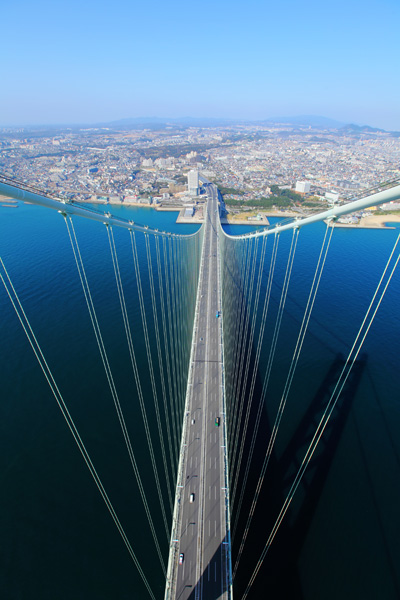
DEFINITIVE DESIGN
Bridge of Messina
The Definitive Design marks the pivotal phase in the realization of the Bridge over the Strait of Messina — the stage where an engineering vision becomes a concrete operational plan.
With the CIPESS resolution of August 6, 2025, the project officially obtained the declaration of public utility, authorizing the start of executive design and preparatory works.
This milestone consolidates years of studies, environmental and technical assessments, and design analyses that have defined dimensions, costs, timelines, and methodologies in detail.
The definitive project confirms the strategic nature of the infrastructure — designed to integrate Sicily and Calabria, improve mobility between the two shores, and strengthen the economy of Southern Italy. Beyond an extraordinary engineering challenge, the Bridge stands as a long-term investment to promote competitiveness, employment, and cohesion across the Mediterranean and European transport corridors.

HIGHLIGHT
Bridge of Messina
Regulatory Framework and Approval Process
Bridge of Messina
The definitive project is framed within a complex legal and regulatory context that recognizes the Messina Bridge as an infrastructure of national and strategic interest.
The CIPESS resolution of August 6, 2025, issued under Article 1 of Decree Law 35/2023, approved the technical documentation, declared the public utility of the work, and authorized the start of executive activities. The resolution incorporates environmental impact assessments (EIA) and the related safety and sustainability requirements.
The process was preceded by the Program Agreement of July 16, 2025, signed by the Ministry of Infrastructure and Transport (MIT), the Ministry of Economy and Finance (MEF), the Regions of Sicily and Calabria, Anas, Rete Ferroviaria Italiana, and Stretto di Messina S.p.A. The agreement defined roles, responsibilities, and coordination mechanisms among the institutional actors.
The project also complies with the Public Procurement Code (Legislative Decree 50/2016) and the Environmental Code (Legislative Decree 152/2006) concerning the protection of coastal and marine ecosystems. Structural and seismic safety standards follow the Italian Technical Construction Standards and the Guidelines for Long-Span Suspension Bridges.
The CIPESS approval concludes a comprehensive evaluation process involving institutions, technical bodies, and international consultants, ensuring the project meets the highest standards of quality, reliability, and environmental compatibility.

Technical Overview
Bridge of Messina

The definitive design defines the essential characteristics of the bridge and its associated infrastructures.
The main work is a single-span suspension bridge of 3,300 meters in length and approximately 60 meters in width.
The deck will carry six traffic lanes (three in each direction) and two central railway tracks, allowing simultaneous movement of vehicles and trains.
The supporting towers, about 399 meters high, will hold four main cables of 1.26 meters in diameter, from which over 500 suspenders will sustain the deck.
Anchorage systems will be made of reinforced concrete blocks totaling over 500,000 m³, ensuring cable stability.
Complementary works include about 40 km of roads and railways, three new railway stations in Messina, and an operations center in Villa San Giovanni.
Environmental mitigation and landscape restoration measures are also planned, such as the reuse of excavated materials for embankments and coastal replenishment.
The project integrates innovative technical solutions to guarantee seismic resistance up to magnitude 7.5 (Mw), aerodynamic stability against winds over 300 km/h, and long-term durability in a marine environment for over two centuries.
Timeline After CIPESS Approval
Bridge of Messina
-
2025 – Publication of the resolution and start of executive design.
-
September / October 2025 – Opening of construction sites with preparatory works (“early works”): access roads, logistics bases, clearance of unexploded ordnance, and temporary relocation of utilities.
-
2026–2027 – Foundation works for towers and anchorages, soil consolidation, start of secondary structures.
-
2028–2029 – Erection of towers, cable spinning, and suspender installation.
-
2030–2031 – Deck assembly, finishing works, and installation of monitoring systems.
-
2032 – Static and dynamic testing.
-
2033 – Bridge opening to traffic.
All stages will be accompanied by continuous environmental supervision and coordination with maritime authorities to ensure safety and environmental protection during and after construction.


A Look Beyond Approval
Bridge of Messina
The approval of the definitive design marks the decisive step toward the construction of the Bridge over the Strait of Messina.
With the precise definition of dimensions, procedures, and safety standards, the permanent connection between Calabria and Sicily enters a concrete operational phase.
The realization of the bridge, together with its complementary works, represents a strategic investment for Italy, aimed at enhancing mobility, competitiveness, and territorial integration across the Mediterranean.
VIDEO
Bridge of Messina









